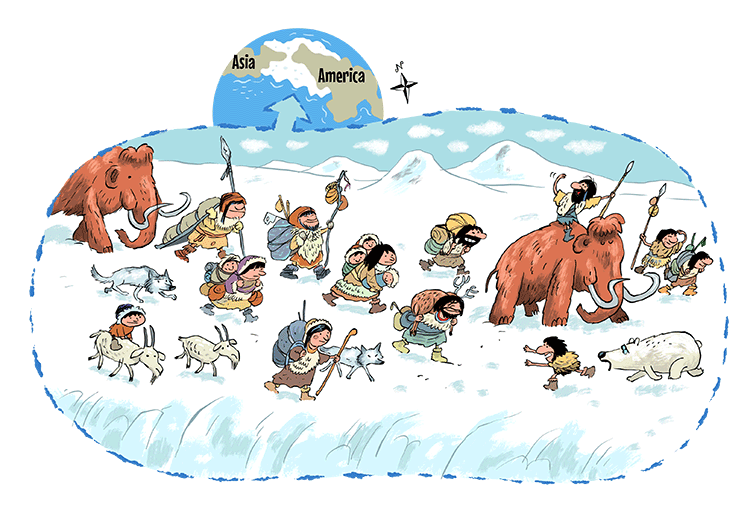Turn your eyes to a map of Alaska. When you do, you’ll notice that Russia is pretty close. Just a small stretch of ocean separates the two countries.
Now, close those eyes and allow yourself to travel 30,000 years back in time. When you open them, things would look quite differently. That small stretch of ocean connecting Alaska with Russia would be gone.
This water didn’t just disappear into thin air, though. Instead, it got locked up in ice during the last Ice Age.
Throughout Earth’s hundreds of millions of years of life, there have been several Ice Ages. They happen when global temperatures drop and lots of the Earth’s water, especially near the North and South Pole, freezes.
During the last Ice Age, enough water was locked up in ice around the poles to drain the little bit of ocean between Alaska and Russia. This created what we now call a “land bridge” and connected the two continents.
That’s right! Some 30,000 years ago, you could walk from North America to Russia. It was a long, cold journey, but you could do it. And that’s exactly what people did.
By the time 1492 AD rolled around, this ice had long-since melted and Europe/Asia and North America had no idea the other existed. This all changed when a man named Christopher Columbus sailed from Spain to what is now the Bahamas, bringing the two worlds together forever.

The First Americans
Just like they do today, people from that era moved around all the time in search of a better life. They traveled to stay close to the animals they hunted or to live in better climates where it was easier to survive.
This quest brought the first waves of people over to North America from Asia. As they moved, some would stop and set up more permanent settlements, while others would keep going and find somewhere else to live. As they did, they settled North America, then Central America, and eventually South America.
It’s difficult to know when all this happened exactly. But the general consensus is somewhere between 10,000 and 30,000 years ago. In other words, a long, long time before some guy named Columbus was even born.
Over time, the planet warmed and the ice melted. This once again separated America and Asia. But it also opened up more areas for people to settle. After initially settling mainly along the coast, they moved inland, populating the entire continent as they went.
Eventually, just like humans did elsewhere, they practiced agriculture and settled into larger communities and cities.
And just like that, American civilization was born. Of course, no one called it that. But these are the earliest roots of the modern nations that exist in North, Central, and South America.
Civilization Before the Arrival of Europeans
Although Europeans and Americans had never had contact with one another before. But the two groups had developed in a similar way. First came agriculture, then towns and cities. As the population grew, so did trade, helping to create larger and more complex societies.
Urban Centers
People lived all across the American continent. In more northern latitudes, population was more scattered. Colder weather meant a dependence on hunting, which often meant moving around frequently.
Closer to the equator, agriculture flourished more easily, and populations grew more quickly and more densely.
A perfect example is Tenochtitlan, one of the largest cities in the world at the time, in the same conversation as Paris or London..
Tenochitlan was the center of a vast empire, which today we call the Aztec Empire. It was just one of hundreds of cities and urban centers that could be found in what is today Mexico, Honduras, Guatemala, El Salvador, Panama, Costa Rica, and more.
Further south, in what is today Peru, Bolivia, and Ecuador, another vast empire existed, known as the Incas. The Incas built a vast system of roads and bridges that connected people all across the region, helping fuel trade and drive population growth.
In North America, while there was no large empire like the Aztecs or Incas, there were people everywhere. Nearly the entire east coast of the continent was populated by different groups. They lived off the land and sea, traded with one another, and sometimes fought.
All of this says one thing: Europeans did not “find” an empty continent. Instead, they visited, for the first time, a massive center of human population that had existed and had been growing for tens of thousands of years.
Trade
European exploration and colonization of America was driven mainly by trade. But when the Europeans arrived, trade was already flourishing across the entire American continent.
The Aztec empire, which dominated central and southern Mexico, was built on centuries-old trade networks that connected different cities across the region. The Incas in South America had built roads and bridges the likes of which Europeans had never seen before. This created a massive network of cities and civilizations that allowed for exceptional prosperity.
In North America, the rivers acted as roads. The Ohio, Tennessee, Mississippi, Missouri, Connecticut, Delaware, Hudon, and Connecticut Rivers, to name just a few, helped goods and people move around the land.
When the Europeans arrived on the continent, they took control of these trade routes by force and built on top of them.
A Dramatic Shift in the History of America
Common European illnesses had never been seen before in America. As these diseases spread, Native Americans died off in masses.
As more and more Americans died, and as more and more Europeans arrived, American people, cultures, and history was driven by Europeans almost to the point of total extinction.
Today, America (North, Central, and South) is home to billions of people and hundreds of countries. European languages, religion, and customs reign supreme, but remnants of America’s ancient past still exist.
Written by Matthew Jones
Illustrated by Jean Galvao
